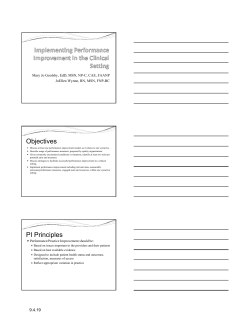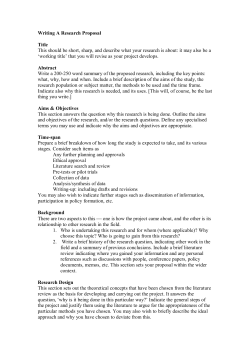
Sample Size Computation with r -power control in the context of
Background
Aims
Methods
Application
Performance
Conclusion
Sample Size Computation with
r -power control in the context of
co-primary endpoints
Philippe Delormea , Pierre Lafaye de Micheaux a ,
Benoˆıt Liquet c,d and J´
er´
emie Riou b,c,d
b
a
Mathematics and statistics department,University of Montr´
eal, CANADA
Danone Research, Clinical Studies Plateform, Centre Daniel Carasso, FRANCE
c
Research Center INSERM U897, ISPED, FRANCE
d
University of Bordeaux Segalen, ISPED, FRANCE
J´
er´
emie RIOU - 27/09/2014
Journ´
ees M.A.S, Toulouse
1
Background
Aims
Methods
Application
Performance
Conclusion
Clinical Context
• The use of multiple endpoints to characterize product
safety and efficacy measures is an increasingly common
feature in recent clinical trials;
• Usually, these endpoints are divided into one primary
endpoint and several secondary endpoints;
• Nevertheless, when we observed a multi factorial effect
it is necessary to use some multiple primary endpoint
or a composite endpoint.
J´
er´
emie RIOU - 27/09/2014
Journ´
ees M.A.S, Toulouse
2
Background
Aims
Methods
Application
Performance
Conclusion
Multiple Testing Context
Underlying problem
Multiple Co-primary endpoints implies multiple testing problem.
J´
er´
emie RIOU - 27/09/2014
Journ´
ees M.A.S, Toulouse
3
Background
Aims
Methods
Application
Performance
Conclusion
Multiple Testing Context
Table : Possible scenarios for m Tests
Null Hypotheses
True
False
Total
Not Rejected
U
T
W
Rejected
V
S
R
Total
m0
m − m0
m
In confirmatory context, during data analysis statistician use
Type-I FWER control:
Type − I FWER = P(V ≥ 1).
J´
er´
emie RIOU - 27/09/2014
Journ´
ees M.A.S, Toulouse
4
Background
Aims
Methods
Application
Performance
Conclusion
Endpoint definition
The choice of the sample size computation procedure depends
on primary endpoint definition.
Primary endpoint definition
• At least one win: At least one test significant among the m;
• At least r win: At least r tests significants among the
m,(1 ≤ r ≤ m);
• All must win: All the m tests significants.
J´
er´
emie RIOU - 27/09/2014
Journ´
ees M.A.S, Toulouse
5
Background
Aims
Methods
Application
Performance
Conclusion
r-Power
Decision rule: At least r wins
At least r tests significant among the m (1 ≤ r ≤ m);
In this context, we want to control the Type-II gFWER:
βr ,m (P) = pr(make at least p − (r − 1) individual Type II errors ),
which is defined by 1- ”r -power” 1 :
1 − βr ,m (P) = pr(reject at least r of the p false null hypotheses).
1
Dunnett, C.W. and Tamhane, A.C.(1992), JASA.
J´
er´
emie RIOU - 27/09/2014
Journ´
ees M.A.S, Toulouse
6
Background
Aims
Methods
Application
Performance
Conclusion
Specific aims
1
2
3
Find a power definition for the interest decision rule (at
least r among m), and a given multiple testing procedure;
Compute the Sample Size for a given multiple testing
procedure;
Develop an
Package to make the work available
(rPowerSampleSize).
J´
er´
emie RIOU - 27/09/2014
Journ´
ees M.A.S, Toulouse
7
Background
Aims
Methods
Application
Performance
Conclusion
Reminders
• m co-primary endpoints;
• Success of the trial is defined by: at least r co-primary
endpoints are significant;
• r-Power control;
• Single step and Stepwise methods.
Step up methods
We focus in this presentation on Step-up methods. Nevertheless, the methodology is available for all Single step and
StepWise methods.
J´
er´
emie RIOU - 27/09/2014
Journ´
ees M.A.S, Toulouse
8
Background
Aims
Methods
Application
Performance
Conclusion
Step-up methods Principle
1
2
Let the order statistics: T1:m ≤ T2:m ≤ . . . ≤ Tm:m
corresponding respectively to H01 , H02 , . . . , H0m ;
Algorithm:
T1:m > v1
yes
H01,...,H0m rejected
no
T2:m > v2
yes
H02,...,H0m rejected,
H01 retained
yes
H0m rejected,
H01,...,H0m-1 retained
no
Tm:m > vm
no
H01,...,H0m retained
J´
er´
emie RIOU - 27/09/2014
Journ´
ees M.A.S, Toulouse
9
Background
Aims
Methods
Application
Performance
Conclusion
Step-up r-Power Formula
1−
βru,m (P)
=
p−r
[
pr
!
(Reject exactly p − t false null hypotheses)
t=0
=
pr
p−r
[
t
\
T(t+1):p > vt+1 ∩
Tj:p ≤ vj
t=0
=
p−r
X
j=1
pr T(t+1):p > vt+1 ∩
t=0
t
\
Tj:p ≤ vj .
j=1
where the vj ’s are critical values for step-up procedures among
the false null hypotheses. In the package, we use procedures which
control the gFWER.
This formula depends on order statistics. We need to use the
Margolin and Maurer Theorem (1976) 2 in order to obtain a
power formula which depends on joint distribution of statistics.
2
Maurer, W. and Margolin, B.H.(1976), The Annals of Statistics.
J´
er´
emie RIOU - 27/09/2014
Journ´
ees M.A.S, Toulouse
10
Background
Aims
Methods
Application
Performance
Conclusion
Power Formula without order statistics
∗
T
T
q
Let a =
P(a1 , . . . , aq ) ∈ N and note a = (a2 , . . . , aq+1 ) with aq+1 = p and a0 = 0,
a+ = qi=1 ai and ∆ai = ai − ai−1 , i ∈ Iq+1 . Let introduce the set
J (a, p) =
n
aq
j ∈ Ip ; jr < jr +1 for r ∈ {ah−1 + 1, . . . , ah − 1}, h ∈ Iq and jr 6= js , 1 ≤ r < s ≤ aq
∗
1−
βru,m (P)
≥
1 − (−1)
(p−r +1)(p−r +2)/2
a
X
a=w
where w = (1, . . . , p − r + 1) and Pa =
P
j∈J (a,p)
(−1)a+ Pa
p−r
Y+1 h=1
(∆ah ) − 1
ah − h
o
.
,
h
n
oi
ai+1
pr ∩p−r
∩k=a
.
i=0
+1 Tjk ≤ vi+1
i
When p = m, namely for a weak control of the type-II r -generalized FWER, the
equation of power becomes an equality.
J´
er´
emie RIOU - 27/09/2014
Journ´
ees M.A.S, Toulouse
11
Background
Aims
Methods
Application
Performance
Conclusion
Sample Size Computation
Step up methods
The developed formula depends only on the joint distribution
and the sample size, and if the joint distribution is known, the
sample size computation is possible.
So, we decided to focus on the continuous endpoints.
J´
er´
emie RIOU - 27/09/2014
Journ´
ees M.A.S, Toulouse
12
Background
Aims
Methods
Application
Performance
Conclusion
Joint distribution
Let X k ∼ N(µk , Σk ) with k = {E , C },
• Unstructured Covariance matrix → Type-II multivariate non
central student distribution
• Asymptotic Context: Multivariate Normal Distribution;
σk2 . . . ρσk2
..
• Σk = ...
→
σk2
.
2
2
ρσk . . . σk
m×m
Type-I multivariate
non-central student
distribution ;
So, in these two last contexts it is possible to compute the
required Sample Size.
J´
er´
emie RIOU - 27/09/2014
Journ´
ees M.A.S, Toulouse
13
Background
Aims
Methods
Application
Performance
Conclusion
Context: ANRS 114 Pneumovac Trial
• Endpoints used in this application for the evaluation of
immunogenicity in the Vaccine trials are means of log-transformed
antibody concentrations for each serotype;
• Data come from ANRS 114 Pneumovac Trial, where the
multivalent vaccines yields a response on 7 serotypes;
• We used data from Pedrono et al (2009);
• Covariance matrices are supposed to be the same between groups;
• The analysis will be performed using seven individual superiority
Student t-statistics;
• What is the required sample size for confirmatory trial with
different decision rules (r )?
J´
er´
emie RIOU - 27/09/2014
Journ´
ees M.A.S, Toulouse
14
Background
Aims
Methods
Application
Performance
Conclusion
Results
Parameters:
0
d = 0m , πr ,m = 0.8, α = 0.05, δ = (0.55, 0.34, 0.38, 0.20, 0.70, 0.38, 0.86) ,
0.124 0.134 0.137 0.075 0.140 0.128 0.161
0.134 0.387 0.287 0.185 0.316 0.295 0.396
0.137 0.287 0.294 0.199 0.274 0.237 0.342
and Σ = 0.075 0.185 0.199 0.369 0.192 0.156 0.238
0.140 0.316 0.274 0.192 0.394 0.264 0.397
0.128 0.295 0.237 0.156 0.264 0.305 0.335
0.161 0.396 0.342 0.238 0.397 0.335 0.651
Table : Sample Size Computation for various definitions of
immunogenicity:
Bonferroni
Holm
Hochberg
r =3
22
21
20
J´
er´
emie RIOU - 27/09/2014
r =5
51
41
40
r =7
116
Journ´
ees M.A.S, Toulouse
15
Background
Aims
Methods
Application
Performance
Conclusion
Performance (1/2)
Recently, authors have used a Monte-Carlo simulation in order
to compute the r-power of a procedure in a clinical trial 3 . The
aim of these slides is to compare it with our approach, in terms of
power and computation time.
•
New treatment against schizophrenia with a primary endpoint based on change
from baseline for three dosing groups;
•
Continuous endpoints, true mean changes are expected to be given by vector
δ = (5.0, 5.0, 3.5)T ;
•
We considered α = 0.025, n = 260, the same standard deviation for each
endpoint (σk = 18) and each group, and the same correlation between all tests
(ρ = 0.5) for each group;
•
We considered Bonferroni, Holm and Hochberg Procedures, and N=100,000
Monte-Carlo simulations.
3
Dmitrienko, A. and D’Agostino, R.(2013), Statistics in Medicine.
J´
er´
emie RIOU - 27/09/2014
Journ´
ees M.A.S, Toulouse
16
Background
Aims
Methods
Performance (2/3) -
Application
Performance
Conclusion
Comparison of Monte Carlo and
rPowerSampleSize
r-Power Comparison
Probability
0.75
Bonferroni−MC
Bonferroni−Sample
0.50
Holm−MC
Holm−Sample
Hochberg−MC
Hochberg−Sample
0.25
0.00
At least one
At least two
J´
er´
emie RIOU - 27/09/2014
All three
Journ´
ees M.A.S, Toulouse
17
Background
Aims
Methods
Performance (3/3) -
Application
Performance
Conclusion
Comparison of Monte Carlo and
rPowerSampleSize
Computation Time (MC)
(rPowerSampleSize)
Computation Time
400
0.020
Bonferroni−MC
200
Holm−MC
Hochberg−MC
100
Execution Time (s)
Execution Time (s)
300
0.015
Bonferroni−Sample
Holm−Sample
0.010
Hochberg−Sample
0.005
0
0.000
At least one
At least two
All three
J´
er´
emie RIOU - 27/09/2014
At least one
At least two
Journ´
ees M.A.S, Toulouse
All three
18
Background
Aims
Methods
Application
Performance
Conclusion
Conclusion
• In this example, power results are similar for both
procedures, and the computation time of
rPowerSampleSize is 20,000 times faster than MC,
• All developed methods are completely new and should
be fully integrated into current clinical practice.
• They allow many statisticians to have a methodology for
sample size computation in line with their clinical
aims, and to obtain more accurate sample sizes.
• The
Package rPowerSampleSize is available soon
on the CRAN.
• This work was submitted for publication.
J´
er´
emie RIOU - 27/09/2014
Journ´
ees M.A.S, Toulouse
19
© Copyright 2025














